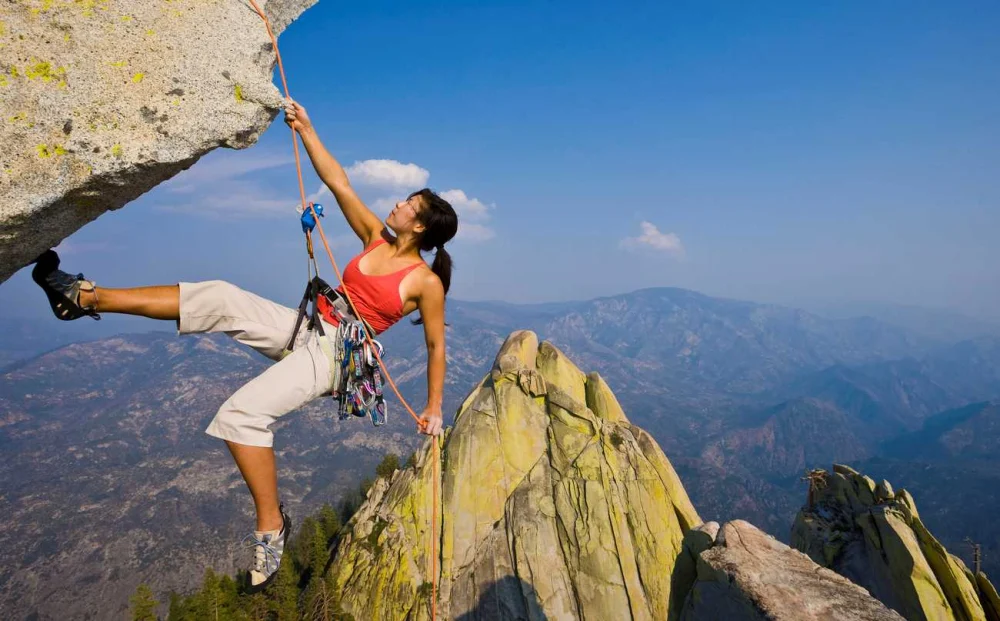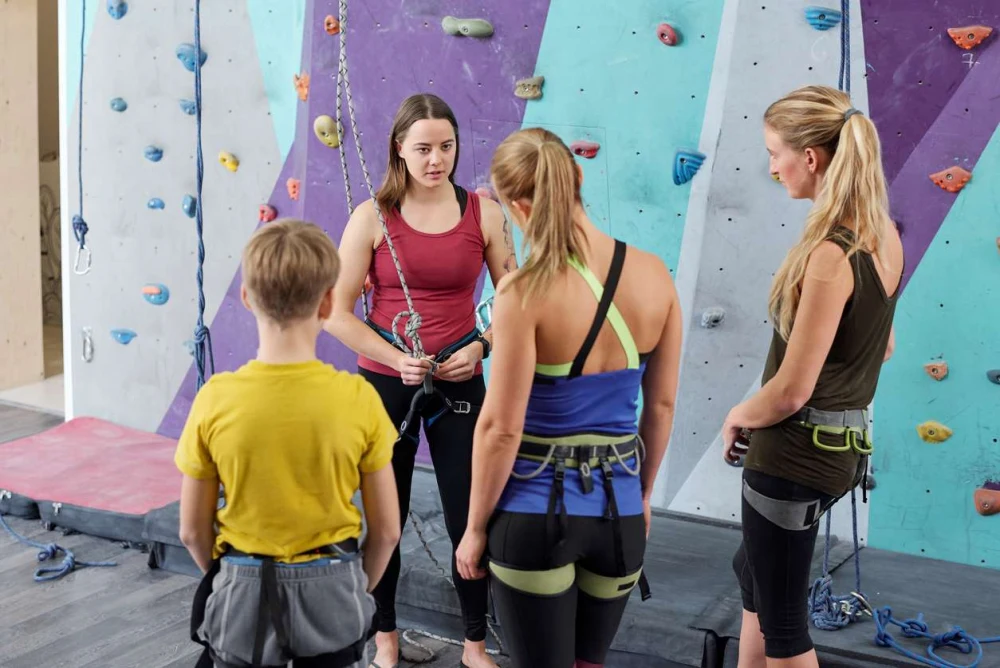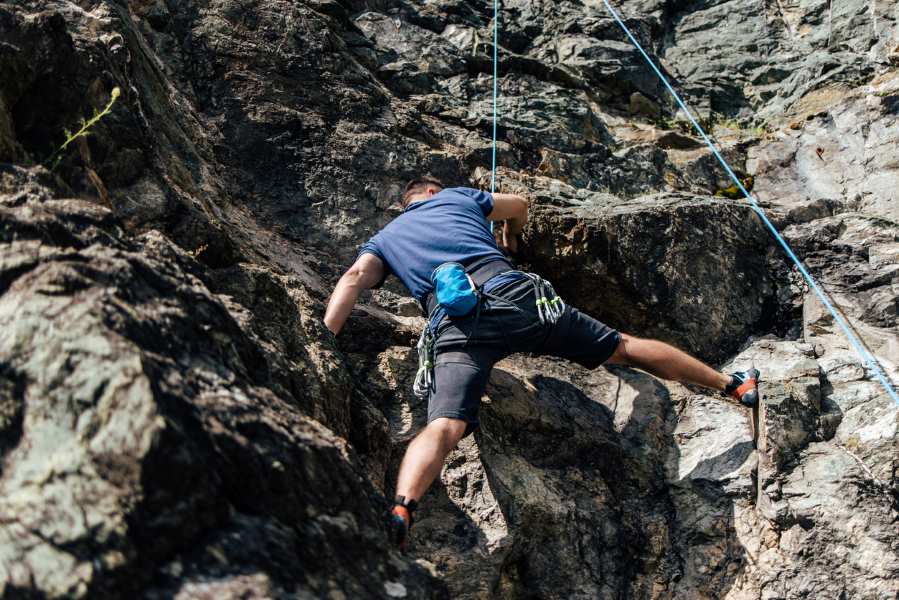
Rock Climbing 101: Bouldering and Climbing Tips to Get Started
September 12, 2023 | Lifestyle
Once a fringe sport for brave adventure seekers, today, rock climbing is accessible to a broad audience thanks to the advancement in climbing equipment, the increase of indoor climbing gyms, and the enthusiasts who have contributed to its growth. Over several decades, rock climbing’s popularity has been influenced by numerous individuals, both men and women, who have significantly contributed to the sport.
Warren Harding and Royal Robbins are respected pioneers of American rock climbing from the 1950s and 1960s. Robbins is known for his significant ascents in Yosemite, and his writings and advocacy for clean climbing practices helped shape the sport’s culture.
Yvon Chouinard, founder of Patagonia, developed innovative climbing equipment and significantly popularized climbing culture. Lynn Hill became the first person to free-climb the Nose of El Capitan in Yosemite. Her achievements helped break gender barriers in climbing.
John Gill is known as the “father of modern bouldering.” His innovative approach to climbing led to the development of bouldering as a distinct discipline within climbing. So whether you want to start bouldering or become a rope climber, you’ll join a vibrant community of climbers who share a deep passion for conquering vertical challenges.
Rock Climbing vs. Bouldering
People love bouldering for its simplicity, requiring a minimum of very little gear—climbing shoes, chalk bag, and crash pads—compared to other outdoor sports. For bouldering at the gym, all you really need is a pair of climbing shoes and a chalk bag to start!
It’s worth noting there are some significant differences between bouldering and rock climbing. Bouldering is the act of climbing a route without a rope and without going too high from the ground. Large, thick pads (some are designed to be worn like backpacks) are placed on the ground below the climber. Bouldering requires more physical strength and the ability to plan routes, requiring a specific solution to ascend the rock successfully.
Rope climbing requires a system of ropes and hardware and experienced partners to ascend much taller walls and uses a lot of expensive niche gear. There are two predominant classes of rope climbing: Sport climbing is when you use permanent bolts (those already in the rock wall) to climb. Trad climbing (traditional climbing) involves placing your gear into the wall as you’re ascending.
Climbing for Beginners
Beginning climbers will likely want to start climbing in the gym to learn techniques and get comfortable with heights. The gym pads are large and designed to cushion falls or jump off the wall if you’re bouldering. Rock walls in a climbing gym are shorter than climbing in the mountains, and the routes are already planned out for you to easily read.
Colored holds (or tape in the older gyms) will show you the route leading up the wall. A difficulty label will be at the bottom of each climbing route: V0-V2 is beginner, V3-V6 is Intermediate, and V7+ is advanced. Start slow and work your way up as you improve!
When you’re ready to start climbing in the great outdoors, it will be similar to the gym, but the routes will be much longer and taller! It’s pretty safe when everyone involved is experienced and trained in the sport. Even so, the fear of heights is very normal.
Climbing Gym Tips

Climbing can be a fun and rewarding activity, but beginners must prioritize safety and learn proper techniques. Here are a few essential climbing tips for beginners:
- For bouldering, learning how to fall is critical to stay safe.
- Establish clear communication with your belayer when climbing at the gym (and outdoors). Practice and know your commands and signals together.
- Learning how to use your rope climbing gear correctly can save your life or someone else’s when outdoors.
- Respecting your limits and a training routine is critical to staying uninjured and progressing.
Climbing is considered a dangerous sport due to the heights involved and the dangers of falling, but with good habits, it is an extremely safe and controlled sport. Once you are comfortable, push yourself to continue improving.
Bouldering Terms
Bouldering is a form of rock climbing that involves ascending short, challenging routes without ropes or harnesses. Thick pads are placed beneath the climber, and spotters are on hand in case of a fall.
Top out: You usually grab a hold or the top of the wall for indoor bouldering to finish. Outdoors: It is traditional to top out, which requires climbing over the boulder and walking down the backside. This is a critical part of the sport that is hard to practice indoors.
To spot: To stand near a climber to ensure they land on the pads safely. A lot of skill and knowledge is required to be a good spotter, and a good spotter is very valuable to have as a friend.
Dyno: To jump from one hold to another dynamically.
Send: To achieve the goal of climbing the route. To go from the very start and finish the top out without touching anything other than the rock
Beta: Climbing jargon that means method, sequence, or movement. It is used to describe the way someone might climb through a challenging or confusing move.
Dab: If you touch something not part of the wall, this is considered a dab. You can dab on people, pads, trees, etc.
Problem: The bouldering version of the route or the path you take up the wall. Boulders are called problems because one of the main parts of the sport is figuring out, using thought, trial, and error, to climb the thing successfully.
Rock Climbing Terms

Rock climbing or rope climbing requires rope and protective gear, including helmets, harnesses, carabiners, and belay devices. It involves ascending natural or artificial rock formations (found in climbing gyms) with experienced partners.
Anchors: These are at the top of a pitch of climbing. You use these to belay, lower, and clean the route.
Pitch: A pitch is a single section of a wall that is climbed in one rope length. Indoors, everything is one pitch, but outdoors, you can run into multi-pitch climbs when the entire cliff is taller than the length of your rope.
Bolt: A permanent piece of gear in the wall that you can clip your gear into
To belay: To manage rope slack to keep the rope tight for your climbing partner. You can do this to keep them tight in place or lower them down. Belaying keeps the climber safe by removing rope slack from the system through a belay device, such as a Grigi (brake).
Route: The line of holds that will be climbed, usually described with a name and a difficulty rating.
Top roping vs. lead climbing: Top rope involves climbing upwards with the rope running through an anchor at the top of the wall. At any point, there isn’t a significant fall risk, and you can easily be lowered when top roping.
Lead climbing is for the experienced climber and involves climbing upwards with the entire rope on the ground. As you go, you clip the rope into bolts in the wall. Climbers can have more significant falls when climbing above their last bolt to clip into the next one. It’s best to pay attention and only lead climb if you know what to do and know what types of dangerous situations to keep an eye out for.
Remember that climbing is a skill that takes time to develop. Be patient with yourself, stay safe, and enjoy the journey of becoming a better climber. Start out at your local rock climbing gym where you’ll find instructors and meet other enthusiastic climbers.
Recreational Gear Climate-Controlled Storage
Maintaining and protecting your recreational gear is essential to extending its useful lifespan, and you may not have space to store miles of rope, climbing equipment, and other types of outdoor sports gear at home.
From tents and camping gear to fishing rods and kayaks, opting for a climate-controlled storage unit offers the ideal solution. Climate-controlled units consistently regulate temperature and humidity to prevent extreme temperature swings when storing your gear throughout the year or between seasons.
Explore our Metro Self Storage locations and gain the peace of mind you need for your upcoming adventures. To learn how we can make room for you, visit our facility or call us today at 888-466-3876. Ready to rent now? Reserve your unit online!



